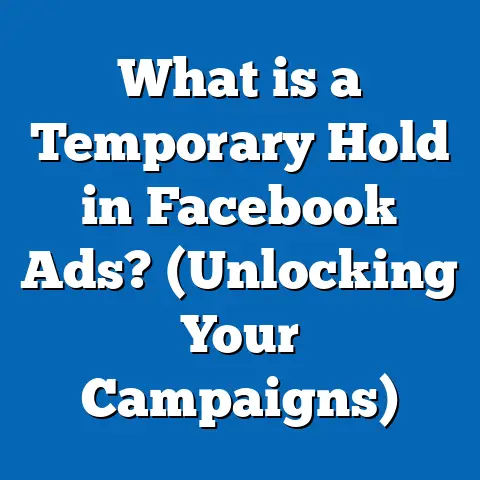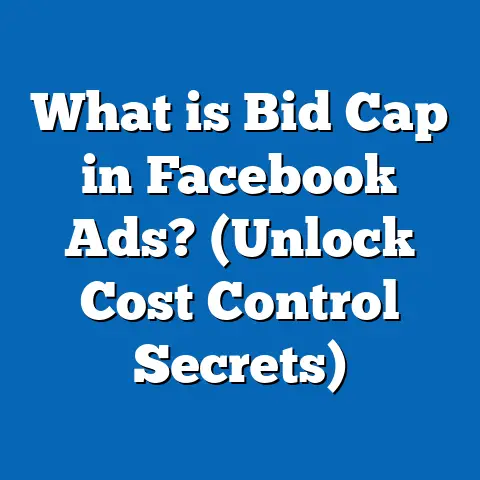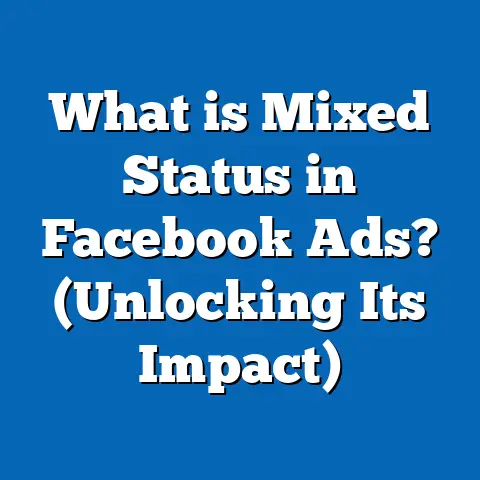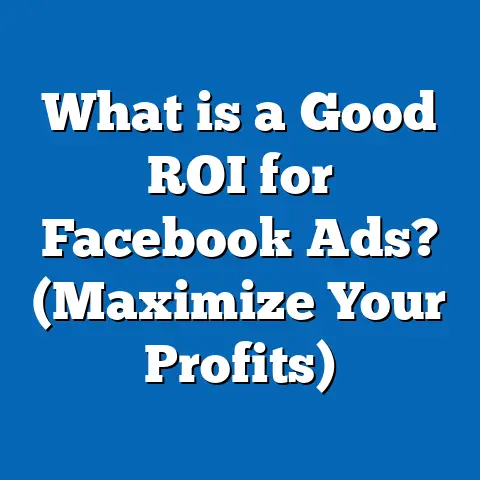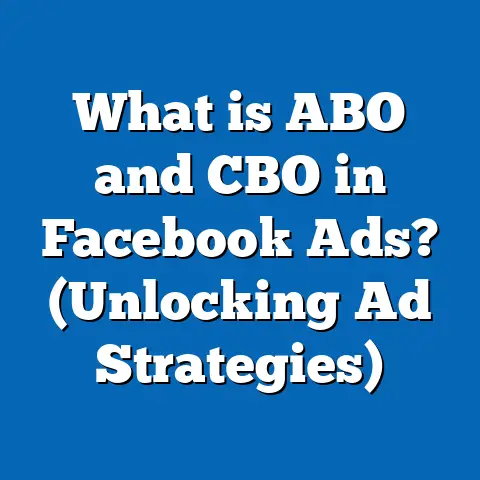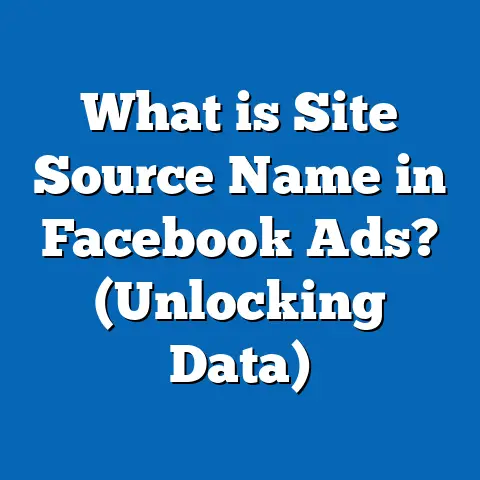What is a Good CPC for Facebook Ads? (Agency Insights Revealed)
Understanding CPC: The Foundation of Facebook Ad Success
What is CPC in Facebook Advertising?
Cost Per Click (CPC) is the amount you pay every time someone clicks on your Facebook ad. Unlike Cost Per Mille (CPM), which measures cost per 1,000 impressions regardless of interaction, CPC specifically tracks the cost tied directly to user engagement through clicks.
CPC is vital because clicks often represent potential customers who have shown interest in your product or service. This metric helps advertisers evaluate the efficiency of their campaigns in driving traffic and interest.
Why CPC Matters for Marketers and Business Owners
Facebook ads are an investment. CPC acts as a key performance indicator (KPI) for understanding how efficiently your budget translates into prospective customer interest.
- Budget Control: CPC directly influences how far your ad budget stretches.
- Ad Performance: A lower CPC usually signals better targeting and creative effectiveness.
- ROI Measurement: When you know your CPC, you can predict how many clicks fit within your budget to generate sales or leads.
- Campaign Optimization: Monitoring CPC over time helps refine campaign parameters to improve performance.
What Factors Influence Facebook Ad CPC?
Pricing in Facebook ads is determined through a real-time auction system. Several factors affect how much you pay per click:
1. Industry and Niche
Competition varies widely between industries, directly impacting CPC.
- Finance and Insurance: Highly competitive with costly keywords; CPC often $3-$7.
- E-commerce: Varies by product type; average CPC ranges $0.50 to $1.50.
- Real Estate: Moderate competition; CPC $1.50-$3.
- B2B Services: Often more expensive due to high-value leads; $3-$6 per click.
- Education: Generally lower CPC ($0.40 – $1), but longer conversion cycles.
Marketers in high-cost industries must focus on maximizing the quality of clicks to justify the higher CPC.
2. Audience Targeting
Narrow and precise targeting tends to lower CPC by showing ads only to relevant people more likely to engage.
- Custom Audiences based on website visitors or past customers often yield lower CPC.
- Lookalike Audiences built from high-value customers may reduce CPC by focusing on similar profiles.
- Broad targeting can increase CPC due to less relevance and engagement.
3. Ad Placement
Facebook’s multiple placements influence CPC:
- News Feed Ads: Generally higher CPC but better engagement.
- Stories: Popular but can have variable CPC depending on creative quality.
- Audience Network: Typically lower CPC but sometimes lower-quality clicks.
- Instagram Placements: May have slightly different CPCs due to audience behavior.
4. Ad Quality and Relevance Score
Facebook uses a relevance score (now called “Ad Quality Ranking”) to measure how well your ad resonates with its audience.
- Higher quality and relevance reduce CPC.
- Poorly targeted or low-quality ads pay more per click.
5. Seasonality and Market Competition
During holiday seasons or major sales events, more advertisers compete for attention, driving CPCs higher.
Data-Backed Insights: What Are Average Facebook CPCs?
Industry Benchmarks (2024 Data)
| Industry | Average CPC (USD) | Notes |
|---|---|---|
| Finance | $3.72 | High competition, valuable conversions |
| E-commerce | $0.70 | Lower CPC, varies by product category |
| Health & Fitness | $1.32 | Moderate competition |
| Real Estate | $2.37 | Requires specific targeting |
| Education | $0.45 | Lower CPC but longer sales cycle |
| B2B | $3.33 | High-value leads increase costs |
Sources: WordStream, AdEspresso 2024 Reports
Regional Differences
CPC also varies regionally:
- U.S., Canada, UK: Generally higher CPC due to intense competition.
- Emerging markets: Often lower CPC but conversion quality may vary.
For example:
| Region | Average Facebook CPC (USD) |
|---|---|
| United States | $1.20 – $3.50 |
| Europe | $0.90 – $2.50 |
| Asia-Pacific | $0.30 – $1.20 |
| Latin America | $0.20 – $0.80 |
Case Study: E-commerce Brand Cuts CPC by 35%
A mid-sized apparel brand ran two campaigns targeting similar audiences:
- Broad targeting with generic creatives: CPC = $1.05
- Segmented audiences with personalized ads: CPC = $0.68
The segmented approach reduced CPC by 35% while increasing ROAS by 25%.
How to Determine If Your CPC is Good
Factor 1: Your Business Model and Goals
Understanding your business model helps define what a good CPC means for you.
- E-commerce: Focus on low CPC with high conversion rates.
- Lead Generation: Balance between cost per lead and lead quality.
- Brand Awareness: Higher CPC may be acceptable if it improves recognition.
Factor 2: Calculate Your Break-Even CPC
To understand what you can afford per click, calculate: Break-even CPC=Conversion Rate×Profit per Conversion\text{Break-even CPC} = \text{Conversion Rate} \times \text{Profit per Conversion}
Example:
- Conversion rate = 5%
- Profit per sale = $100
- Break-even CPC = 0.05×100=$50.05 \times 100 = \$5
If your actual CPC is below this number, your campaign is profitable.
Factor 3: Compare Against Industry Benchmarks
Use published benchmarks as reference but adjust according to your niche and region.
Deep Dive: How to Calculate and Analyze Your Facebook Ads CPC
Step 1: Accessing Your Facebook Ads Manager Data
Navigate to your Ads Manager dashboard:
- Select the campaign/ad set/ad level.
- Customize columns to include metrics like Cost per Link Click, Cost per Result, CTR (Click Through Rate), and Conversion Rate.
Step 2: Understanding Metrics in Relation to CPC
- CTR affects CPC: Higher CTR often lowers CPC since Facebook rewards engaging ads.
- Conversion Rate: Helps determine if clicks are valuable.
Example: If CTR is low but you have a low CPC, it may mean clicks are cheap but less relevant.
Step 3: Segment Data for Deeper Insights
Analyze performance by:
- Age groups
- Gender
- Placement
- Device type
- Geographic location
This helps identify where you get the best value per click.
Advanced Strategies to Improve Your Facebook Ad CPC
Strategy 1: Use Behavioral and Interest-Based Targeting Wisely
Target audiences based on multiple data points:
- Interests + behaviors + demographics combination reduces wasted impressions.
Example: For a fitness product, target users interested in “running,” “healthy eating,” and aged 25–40.
Strategy 2: Expand Custom Audiences with Lookalikes
Generate lookalike audiences from:
- High-value purchasers
- Newsletter subscribers
- Frequent website visitors
Lookalikes help find new users similar to your best customers at lower costs than cold targeting.
Strategy 3: Optimize Ad Creative for Mobile Viewing
Over 90% of Facebook users access via mobile devices.
Tips:
- Use vertical video formats or square images.
- Keep text concise.
- Use bold visuals that stand out on small screens.
Mobile-friendly ads tend to have higher engagement and lower CPC.
Strategy 4: Use Dynamic Creative Testing
Facebook allows automatic combinations of headlines, images, descriptions, and CTAs to identify best-performing combinations.
This method reduces manual testing time and can lower overall CPC by finding optimal creative sets faster.
Strategy 5: Implement Conversion API and Pixel Tracking Correctly
Accurate tracking ensures Facebook optimizes for real conversions instead of just clicks.
Proper setup improves ad delivery efficiency and can reduce unnecessary clicks that don’t convert.
Retargeting Campaigns: The Secret Weapon for Lower CPC
Retargeting users who already interacted with your brand typically results in:
- Higher CTR
- Lower CPC
- Improved conversion rates
Examples of retargeting audiences:
- Website visitors in last 30 days
- Cart abandoners
- Video viewers who watched more than 50%
Case Study: SaaS Company Retargeting Strategy
A SaaS company used retargeting on users who downloaded a free trial guide but did not sign up:
- Initial cold campaign CPC: $4.00
- Retargeting campaign CPC: $1.20
- Conversion rate increased by 40% on retargeted audience
This shows how retargeting can sharply reduce costs while improving conversion quality.
Using Facebook’s Automated Bidding Options for Better Cost Control
Facebook offers several bidding strategies impacting your CPC:
Lowest Cost Bidding
Facebook tries to get the lowest possible cost per result without limits.
Good for campaigns with flexible budgets but can cause fluctuating costs during competition peaks.
Cost Cap Bidding
Set a maximum average cost you want per result (e.g., $2 per click).
Facebook tries to keep costs near this cap while maximizing results.
Helps maintain predictable spending without overspending in auctions.
Bid Cap Bidding
Set a hard maximum bid in auctions (e.g., max bid $3).
Gives tighter control but may reduce delivery volume if bids are too low.
Comparing Facebook Ads with Other Platforms’ CPCs
Knowing how Facebook stacks up helps set realistic expectations.
| Platform | Average CPC (USD) | Pros | Cons |
|---|---|---|---|
| Google Ads | $1 – $2 | High purchase intent users | Higher cost per click |
| LinkedIn Ads | $5 – $6 | Precise B2B targeting | Expensive |
| Twitter Ads | $0.50 – $2 | Good for brand engagement | Variable conversion quality |
| TikTok Ads | $0.10 – $1 | Low cost, younger audience | Newer platform; less data |
| Pinterest Ads | $0.20 – $1 | Visual discovery platform | Less mature ad tools |
Facebook balances cost with audience reach and advanced targeting capabilities.
Exploring Common Misconceptions About Facebook Ad CPC
Misconception #1: Lower CPC Always Means Better Campaigns
Lower cost clicks may come from irrelevant users or bots leading to poor conversions.
Focus on quality clicks that convert rather than just cheap clicks.
Misconception #2: High CPC Means Failure
High-value products or competitive industries naturally have higher CPCs but can still be highly profitable.
Example: A luxury car brand paying $10 per click but converting at 10% with an average sale of $100,000 is successful despite high cost per click.
Practical Examples of Good vs Poor Facebook Ad Campaigns Based on CPC
Example #1: Local Gym Membership Drive
Objective: Gain new memberships through trial offers.
Results:
- Average CPC: $0.75
- Conversion Rate (trial signup): 15%
- Cost per lead: $5
- ROI positive due to low acquisition cost and recurring memberships
Key takeaway: Focused local targeting with strong CTA lowered costs effectively.
Example #2: Startup App Install Campaign with Poor Targeting
Objective: Drive app installs globally without audience segmentation.
Results:
- Average CPC: $2.50
- Conversion Rate: <1%
- Cost per install: Over budget
Key takeaway: Broad targeting led to high costs and poor conversion rates; segmentation needed urgently.
Latest Trends Impacting Facebook Ad CPC in 2024
Trend #1: AI-Powered Audience Segmentation and Ad Optimization
AI tools analyze massive datasets for better lookalike audiences and creative optimization — reducing wasted spend and lowering average CPC over time.
Trend #2: Privacy Changes Affecting Ad Tracking and Attribution
Apple iOS updates limit tracking accuracy impacting retargeting effectiveness; advertisers may see increased effective costs due to less efficient optimization.
Trend #3: Video Content Dominance Continues
Facebook pushes video formats over static images which generally get better engagement metrics leading to lower relative CPCs when done well.
Additional Tips for Optimizing Your Facebook Ads for Lower CPC
Use Clear Calls-to-Action (CTAs)
Strong CTAs drive higher click-through rates that reduce average costs.
Examples:
- “Shop Now”
- “Get Your Free Trial”
- “Learn More”
Schedule Ads During Peak Engagement Hours
Run campaigns when your target audience is most active online — often early evenings or weekends — increasing CTR and lowering cost per click.
Avoid Overusing Text in Images
Facebook limits text coverage in ad images; images with less than 20% text tend to perform better resulting in lower costs.
Summary of Best Practices to Achieve Good Facebook Ads CPC
- Understand your industry benchmarks and calculate break-even CPC.
- Refine audience targeting using custom and lookalike audiences.
- Create high-quality creatives optimized for mobile.
- Use retargeting campaigns aggressively.
- Leverage Facebook’s automated bidding strategies effectively.
- Continuously test and optimize ad copy, images, videos.
- Track key metrics regularly and segment data for insights.
- Stay updated on platform changes affecting ad delivery and tracking.
- Combine data-driven decisions with creative innovation.
- Don’t focus solely on cheap clicks; prioritize conversion quality.
Conclusion: Harnessing Facebook Ads for Maximum Value at Optimal Cost Per Click
Understanding what constitutes a good Facebook ad CPC is part art, part science. It requires balancing precise targeting, compelling creative content, strategic bidding, and ongoing optimization against your business goals and industry realities.
The luxury lies in mastering these elements — turning every dollar spent into meaningful engagements that drive growth and profitability for your business. By applying the insights shared here, marketers can confidently navigate Facebook’s complex ad ecosystem to achieve efficient, scalable campaigns with strong returns on investment.

